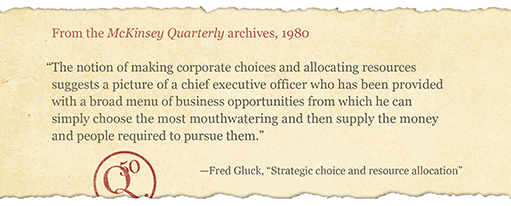Over the last 50 years, the theory and practice of business strategy have taken a variety of twists and turns. In the 1960s, strategy was equated largely with corporate planning; in the 1970s, the emphasis switched to diversification and portfolio planning. The focus shifted to the economics of industry attractiveness and value chains in the 1980s, and the 1990s were characterized by a concern with core competencies. More recently, practitioners and academics alike have been grappling with the impact on strategy of rapid market and technological change, growing external risk, and the advent of big data.
What comes next? How relevant are existing frameworks and tools to the needs of leaders seeking to develop and implement winning strategies? And what should be the relative contributions of academics and practitioners to the evolution of the field? In March of this year, McKinsey Quarterly convened a unique group of experts (see sidebar “When theory met practice”), who brought competing and complementary perspectives to bear on these and related issues. What emerged was the sense of a field in flux, with enormous opportunities to generate fresh insights in a changing world, as well as some unfinished business to ensure that the human realities of strategic decision making receive sufficient emphasis.
Here are highlights of the discussion, moderated by McKinsey Quarterly’s Allen Webb, among five practitioners, five business-school professors, and five current or former leaders of McKinsey’s Strategy Practice, including Fred Gluck, its founder.
Where have all the frameworks gone?
Professor Pankaj Ghemawat (IESE)
At the millennium, I wrote a piece on new management paradigms, which I referred to as Eureka and BOHICA. The latter term was popularized in business circles by John Micklethwait and Adrian Wooldridge at the Economist and stands for “bend over, here it comes again.” The reason for writing it was that there seemed to be a profusion of ideas about strategy that were new or at least claimed to be new. This situation seems to have changed drastically. For example, the management writer Richard Pascale supplied an amusing chart on the ebbs, flows, and residual impact of business ideas and fads for my original piece—but when I contacted him recently, he told me he had stopped updating the series a few years ago because activity had dropped off. Is that true and, if so, is it a matter for concern?
Professor Michael G. Jacobides (London Business School)
Yes, I think we may need new tools or frameworks. When the environment changes profoundly, the maps with which we navigate it may need to shift as well. For instance, from telco to healthcare to computers, sector boundaries are changing or dissolving, and new business models are redefining the competitive landscape. So tools such as Michael Porter’s five forces, created for a more stable, more easily definable world, don’t just lose their relevance—they become actively misleading.
Strategy tools are abstractions from reality that illuminate and identify some features and causal relations while simplifying or omitting others. So their usefulness depends on context, and their effectiveness changes with time. Consider, for instance, the financial crisis. Regulators were caught by surprise in 2008 because they failed to understand how much the financial sector had been transformed from a set of integrated institutions into a host of co-specialized firms that have divergent business models and are linked through the capital markets. Only now are we slowly updating our mental map of the sector and the tools we use to analyze it.
That said, I’d strike a slightly more optimistic note; I believe there’s scope to help people organize and categorize information without having their heads explode. And as a strategy professor, I can’t think of anything better than saying, “Let’s rethink these frameworks together with people who use them in their professional practice, and revise the strategy canon.”
Professor Robert Grant (Bocconi School of Management)
I disagree with the notion that the world is changing and that this has somehow made our established strategy tools obsolete. Most changes in the business environment have been in degree rather than kind: the speedier diffusion of technology, the growing intensity of competition as a result of internationalization, increased concern over business’s social and environmental responsibilities. Most of the core concepts and frameworks of strategy have not been devalued by change. A.G. Lafley and Roger Martin’s recent book, Playing to Win,1 builds upon the traditional notions that superior performance results from selecting attractive markets and establishing a competitive advantage within them.
What’s changed is not so much the environment as our empirical and theoretical knowledge about strategy. Our understanding of the experience curve has been augmented by deeper insights into the determinants of organizational learning. Our analysis of competition extends well beyond Porter’s five-forces framework, to recognize the role of complements, network externalities, and platforms. Our understanding of the benefits of strategic flexibility has been transformed by the analysis of real options. A major problem is that the theoretical and empirical research in strategy has moved so quickly, and over such a broad front, that its distillation into intuitive concepts and frameworks applicable to strategy-making processes of firms has lagged far behind.
Sven Smit (McKinsey)
I don’t think the supply side of frameworks has dried up. The analysis of data at a granular level—for example, in relation to the 600 cities McKinsey has identified as driving more than 60 percent of the world’s growth—is inspiring a massive amount of work in companies on how to execute a strategy.2 The framework is now those 600 cities, not a simplified 2x2 matrix. Where are they? What are their names? How do you assess them? What’s the S-curve effect of the demand for sugar or coffee or yogurt in Chengdu, China?
Professor Michael G. Jacobides (London Business School)
I’d agree that there is a lot of good work on tendencies that matter to organizations—urbanization, globalization, particular technologies from 3-D printing to big data—and on their impact. Much of it has been done by the McKinsey Global Institute and published in the Quarterly. And this is where consultants (as opposed to academics) add value—not so much by providing information per se, which will increasingly become a commodity, as by identifying the important dimensions within the morass of data we now have at our fingertips. Yet this skill isn’t quite a framework or a tool. My view is that we need both the consultant- or firm-driven focus on “themes” and better frameworks, not only to teach strategy, but also to help executives rethink what they do, perhaps by helping to improve their judgment, to frame difficult problems, or to deal with individual or organizational biases. We should ask ourselves what types of frameworks can work best.
Professor Laurence Capron (INSEAD)
I see most excitement on the faces of my MBA and executive MBA students when they are presented with frameworks that enable them to generate different options and discuss a way forward. The value curve is one example, the Haspeslagh and Jemison matrix3 on postmerger integration another.
From frameworks to synthesis
Sudeep Maitra (Centrica)
Before Centrica announced a new strategy in the beginning of 2013, we did consider scenarios, one of which had greater regulatory and political intervention in the UK energy sector. But in practice, there’s probably no framework or strategy tool that can prepare you for the industry being in the center of a highly charged political and public debate, which has played out in 2014.
Sven Smit (McKinsey)
Very few traditional frameworks, even scenario planning, were built for “black swan” events, which many companies now face every ten years or so. And a lot of frameworks are still presented in very qualitative terms. What’s different today is the availability of data, which means you can research the frameworks’ empirical validity.
Mark Wilson (Unilever)
I agree. From my perspective in a global company, new strategy thinking—frameworks and so on—seems to emerge mainly from books, which makes it seem more of a literary than a scientific process. What people in my position want to know is which techniques are scientifically proven, so we can discard the rest.
The issue is also how to spread good ones to very busy executives in the businesses—and then get the executives to use them. One reason our frameworks often seem out of date is that managers persevere to the point of desperation with the familiar things they learned 10, 20, or 30 years ago, perhaps mixed with what they’ve come across in more recent management training or what they’ve read in the literature. The trigger point for adopting new thinking in an organization often comes when you have worn out the old stuff and it clearly doesn’t work anymore or when business performance has slumped.
Professor Julian Birkinshaw (London Business School)
As academics, we have incentives to come up with new ideas. But when you’re trying to write an article, you can’t just say, “I’ve got this bright idea.” You need evidence, and it’s almost always the case that the actual innovator is a company. The balanced scorecard is a great example. Bob Kaplan didn’t invent the balanced scorecard. He saw it happening in Analog Devices, but he was the one who “branded” it, put a great wrapper around it, and said, “This is how it works.” So we’re all complicit in the creation of new ideas. Companies call consultants and academics when things aren’t going well, and the academics want to pick up on the stuff that companies are doing.
Sven Smit (McKinsey)
The trouble is that when these methods derive from one or even a handful of companies, the empirical validity is zero. There is a halo effect. What might have worked at Analog Devices might not work in other industries and might not even be the core reason Analog Devices was great.
Sudeep Maitra (Centrica)
I agree that strategy tools are only effective if they provide executives with a way to get a comprehensive view of their company in the context of industry as a whole. You can go to an oil-and-gas conference and get an oil-and-gas perspective. Then, you go to another conference and see things from a supply-chain angle. There are competing frameworks that overlap and it’s often confusing. It is quite important to have effective frameworks that pull together these different views into a comprehensive picture.
Fred Gluck (McKinsey)
We’ve talked about frameworks in the context of analysis, but my test is whether they are useful for synthesis. If not, what’s the process for getting a good synthesis? That’s where the strategies come from. A strategy is not the obverse of an analysis. It usually comes from some creative insight. I think the real opportunity in strategy development is on the synthesis side—figuring out how to deal with a faster-changing environment. I like to characterize strategy as coming from three places: strategic planning, strategic thinking, and opportunistic decision making. My prejudice is that most of it comes from strategic thinking and opportunistic decision making. Something happens out there; you see it and you act faster. The strategic-planning process can deteriorate into an exercise of applying techniques and frameworks.
What do companies want from strategy?
Mark Reckitt (Smiths Group)
I run a division within Smiths, and that division is a collection of small businesses, with an average turnover of around £50 million. We use incredibly simple 2x2 matrices to explain the structure or segment of an industry in sufficient detail that people can understand what customers they want to get close to and who their competitors are.
What our businesses are after is insight. Multi-industrial companies report at a pretty high level, so it’s very difficult to find out exactly what our competitors are doing at the microlevel. Most of all, we need to hear the voice of the customer and what he or she is prepared to pay for. That will enable us to develop a product we can make money out of over five or ten years or whatever the length of the product cycle might be.
We also need ways to assess our competencies objectively. Time and time again, I come across people who claim they have the greatest insight into their particular sector. Actually, it turns out that they know more about the engineering or the science in that sector than most people, but they don’t look beyond their own cubicle or research lab.
The final thing we too often lack is something to help distinguish between the cyclical and the structural shifts that go on in an industry. In any year, we hear about four or five different things that are happening. Some will only be very short-term changes; others will be almost permanent. The question is which are which. (For more on this and other critical needs identified by participants, see sidebar “Help wanted! Seven needs for today’s strategist.”)
Dan Simpson (Clorox)
I agree with Mark that assessing competencies objectively is always a challenge, though we did some work at Clorox to try to address that. (For more, see Simpson’s essay on clarifying capabilities in “Synthesis, capabilities, and overlooked insights: Next frontiers for strategists.”)
One of the toughest strategy challenges is still the creation of options—creating them is the black box of strategy. It’s easy to write “diverge” on the strategy-process map, but it’s darned difficult to create truly innovative strategy options.
Oddly enough—and it just may be a function of Clorox’s proximity to Silicon Valley—the better tools for creating options don’t seem to come from strategy but rather from product innovation. Recently, design-thinking methodologies made popular by Stanford’s Institute of Design, IDEO,4 and others have been significantly changing product innovation. I at least wonder if the key principles of reframing the market, customer empathy, and rapid prototyping can be used to improve the creation of options in strategy.
Framing questions is the other tough challenge, and it’s one of the most important yet underappreciated parts of strategy development. Questions are the lens by which problems are defined and addressed. Generating great answers to bad questions is all too common and not all that helpful in strategy.
The other reason framing questions is critical is that, while analysis is very important, developing strategies is ultimately a people-centric process fueled by conversation. Each player brings his or her experiences and biases to the table, and the job of crafting a strategy is to navigate those in a way that is productive. The key is the good questions, and any advice on how to improve questions would be really helpful.
Mark Wilson (Unilever)
What’s also important are methods that challenge organizational inertia—notably inertia in the form of senior leaders who naturally tend to protect their own share of resources, as well as reward systems that have a momentum of their own. External stimuli, including pressure from the consumer and competitors, help to shift thinking, and any tool that makes you stop and think is useful. In business, we can move too quickly from problem to solution, without spending enough time on the diagnosis.
In very large networked organizations like my own, there is huge value attached to the discipline of implementation. We employ a lot of bright people who have specific implementation roles to play, but because of this we don’t always reward them for thinking creatively.
If it’s really true that the strategy community is currently focused more on producing insights than new techniques, that’s probably a good thing. It’s incredibly valuable to have insights coming from outside to jolt your thinking. Most executives are still surprisingly ill informed about what goes on outside the walls of their own businesses.
Sudeep Maitra (Centrica)
For me one of the most important things is a set of dynamic tools to deal with, or at least understand, uncertainty. I want to be able to paint the landscape while keeping options open—allocating resources over time and moving them around as events unfold. You can’t do resource allocation or capability building without an indication of the way ahead.
I also need an evidence-based view of how the customer might evolve in the future. People are stuck between focus groups on the one hand and the Steve Jobs approach (“I will know what customers need before they know it themselves”) on the other. The Jobs way is compelling, but it’s risky. The challenge is the journey from today’s customer, whom most companies understand well, to tomorrow’s customer, whom they don’t. On top of this, you’re dealing with competitors and policy makers in an interactive system. Scenarios that are completely macroeconomic or play back a “single shot” set of responses don’t reflect the reality that something unexpected will happen in the external environment.
Matt McEvoy (Burberry)
Burberry operates in a very fragmented industry, where the ability to maintain market share is always dependent on the brand. Because our market share is so small, we always feel that if we do something great, it can actually be meaningful.
We probably don’t think enough about the way competitors move; the thing we lack most is probably a better view of the competitive environment. Information is very anecdotal in the countries where we operate, so maintaining the brand, which protects you from the ins and outs of fashion, is our number-one priority.
Professor Pankaj Ghemawat (IESE)
Obviously, the chief strategy officers who have weighed in know more about what companies want from strategy than I do. But as an academic, I do find their very practical suggestions striking, partly because of the disconnect with current conversations among strategy researchers in academia. Even more alarmingly, this disconnect seems to have worsened in recent years.
It seems to me that there is a major missed opportunity here: if there were more forums for interchange between academics and practitioners—something that this roundtable has attempted to provide, albeit in a small-scale way—we might be more likely to see academic research that accounts for and tries to address at least some of the practitioners’ concerns and needs.
The social side of strategy
Professor Laurence Capron (INSEAD)
I’ve become increasingly aware of how important nonrational issues are in strategy setting. An obvious example is that some CEOs tend to be biased toward M&A, which can have enormous implications for corporate priorities.
Professor Michael G. Jacobides (London Business School)
We shouldn’t forget that strategy frameworks are also tools to allow political conversations—to help navigate the political tensions in a corporation. Strategy discussions are invariably burdened by resource-allocation agendas; actually, what’s labeled “strategic” is often what is politically protected by senior management, not what’s most valuable for a firm. Many a strategy discussion is actually about executives saying, “You aren’t going to cut my unit.” I was recently talking to a senior executive from a global pharma firm who described the internal squabbles about which tools to use to evaluate the portfolio, as everyone knew how the “right” tool would shape the kudos and budget they would get.

Sven Smit (McKinsey)
I agree that much of the song and dance called strategy in companies is really a resource-allocation process laced with pride. I have yet to see anybody say, “I understand my business is on the way down. I will give you $50 million cash back this year and the same again next year. I can see lots of good opportunities in the company for us to better use that $50 million!”
In resource-allocation negotiations, there’s a stretch target and a “sandbagging” target; in between sits the realistic target. At the best companies, the social game is a real fight. When individuals aggressively dispute other people’s insights with facts, that’s a good process. Too often, those involved just hope the CEO moves their way, and they don’t really discuss content.
Professor Michael G. Jacobides (London Business School)
In both teaching and research, I think we don’t pay enough attention to the difference between strategy as resource allocation and strategy as insight generation. There is a yearly strategy process, which focuses on resource allocation. We should acknowledge it as such and better understand its pathologies. But we also need to take a fresh look at how we identify ways to improve a firm’s positioning and performance, by explicitly asking, “What insight-generating activities, tools, and frameworks would be useful?”
Conor Kehoe (McKinsey)
You’d be for a proposal of ours: we rename the annual strategy process the strategic-allocation or the reallocation process. And we have something separate called the strategic review.
Sven Smit (McKinsey)
We would argue that good resource allocation is an outcome of strategy. There’s a lot of empirical evidence that, actually, the strategist cannot pick the winner but can pick the loser. It’s about killing stuff more than about promoting stuff. Then, when you recognize the winner, promote it and give it resources. But picking the winner, as we know from the segment-level data on venture capital and private equity, is harder than weeding out the loser. We also know it from distributions of M&A, we know it from marketing projects, we know it from R&D projects—picking the R&D winners is much harder than preventing a loss. I have yet to see the company where the process gives 90 percent of the time to deciding what we’re not going to do, with the hope that by not doing certain things the rest will prosper.
Mark Reckitt (Smiths Group)
Fifteen years ago, we did a rigorous, activity-based cost analysis to work out the payoff product by product, country by country, and we ended up with some real danglers, which we just cut. Some were really embarrassing: products had been launched by people who at that point were CEOs. And the fact that we cut such a product says to everyone, “Look, you’re going to make mistakes. It doesn’t matter. Don’t worry about it too much.” And that freed up huge resources, both financial and management, to push harder on the things that were really successful.
Mark Wilson (Unilever)
Someone once said to me, “Do you know something about projects in a business? Up to a certain point, they’re almost impossible to keep alive, and then they flip virtually overnight to being almost impossible to kill.” And that state can change over just a few weeks. It’s a function of gatekeeping processes and which reputations have become sufficiently attached to the project.


